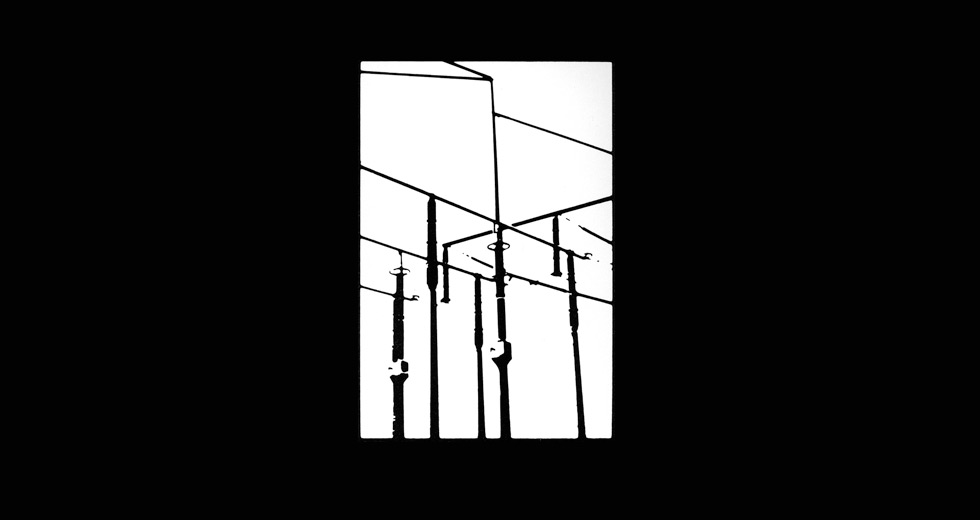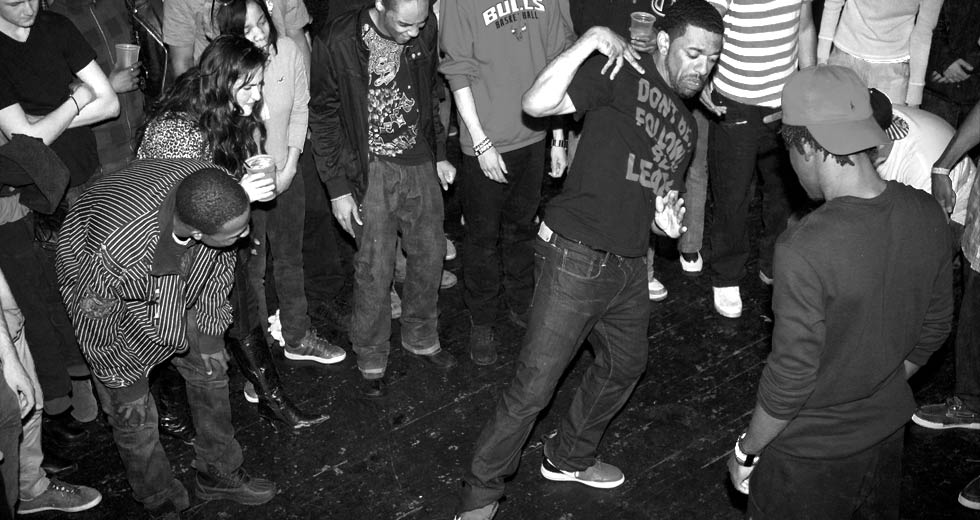House Music’s Detail Shop
If you look closely at many of the most sought-after American deep house, ghetto house, and techno records, you’ll notice one thing in common – Mark Richardson’s initials, “MJR,” inscribed in the run-out groove. “Percolator.” “Dem Young Sconies.” Round Two’s “New Day.” They all came through Mark’s mastering studio. At the end of this month, Mark will finally retire, so we sent Jacob Arnold to a small town in Illinois to talk with the legendary mastering engineer as he closes up shop.

Among the corn and bean fields of Belvidere, Illinois, some 70 miles from downtown Chicago, in a windowless red metal barn by a flower-filled patch of prairie, Mark Richardson spends all day cutting lacquer masters for records – from noise and death metal to house and techno, all by artists he has never met.
As I watch, Mark moves smoothly around his Neumann VMS 80 lathe, cutting six sides of punk rock. As the finishing touch to each lacquer, he inscribes the catalog number and his initials, then blows away debris with a puff of compressed nitrogen. By his count, Mark has cut 14,500 records on this equipment (only a fraction of which are credited on Discogs) since teaching himself how to use it in 1988. At the end of September 2014, he will cut his last record.
Richardson, who is about to turn 59, was born and raised in Elgin, Illinois. At the age of 15, Mark heard Black Sabbath’s debut album at a cousin’s house. “That changed my life right there,” he says. A year later, he dropped out of high school. “[I] got into playing guitar with a few local bands and had some fun, but didn’t consider myself the best guitarist ever, so I got curious and interested in recording studios in my mid-twenties,” Mark explains. Initially he worked as an independent engineer. In 1988, though, he was introduced to Matt Harrington, who was preparing to open Session Masters. “We got to talking and a few months later he called me and asked me if I wanted to be his cutting engineer,” Mark recalls. Before long, Larry Sturm, a studio engineer whom Mark had worked with previously, approached Mark about cutting some Steve “Silk” Hurley and Jamie Principle productions on D.J. World Records.
After a few successful projects for Sturm, house music producers began seeking Mark out. At the time, he says, “It seemed like there was a club or a house record label on just about every street corner.” Over his years at Session Masters, Mark mastered records for D.J. International, Streetside, House Jam Records, and the Hot Mix 5.1

Asked to describe mastering to the layperson, Mark says to imagine an artist who builds custom cars. “Once you finish building that car, you need to send it off to the detail shop in order to get it shined up, looking and being as good as it can be,” he explains. “That’s what I do. I’m the detail shop for music.”
Mark receives music and then runs it through the Neumann console until it sounds good and is suitable for pressing on vinyl without distortion. In the ’80s, the music was delivered on tape, but that switched to DAT, then CD-R. Now artists just share their tracks with him online.
“I’ve always considered vinyl as a format to be a compromise, and not necessarily a good one,” Mark admits. “So what I’ve always strived to do with every record I’ve ever done is to come up with a way to get that person’s music onto the format without complications. And what I mean by that is distortion – added distortion of the format. Most people easily recognize something like that if they’ve listened to a lot of records as sibilant distortion. You’re listening to the record and the vocalist comes along with a strong ‘s’ or even a ‘t’ or a ‘p’... and you hear this nasty distortion there for a second.
“When I was a kid listening to records, I absolutely hated that,” continues Mark. “And so it’s always been my goal to get a record cut as loud as I can cut it but as cleanly as I can cut it, and that’s where the challenge has been.”
Once Mark has the mastering settings he wants, he takes a 14-inch acetate-coated aluminum disc and cuts the groove that will appear on the final 12-inch record using a synthetic ruby cutting head cooled by a small but steady stream of helium. This lacquer disc is then sent to the pressing plant, where it is coated with nickel to create the stamper that will press the final, commercial records.
In the mastering phase, Mark rarely uses any external processing. “I’m a firm believer in a minimal signal path,” he explains. “Less than one percent of the records I’ve ever cut have had any compression or limiting done in this stage.” One of the few non-Neumann components in Mark’s console is a pair of Orban 642B equalizers that he uses on less than five percent of his projects.
“I’ve always been very independent. I’ve never listened to anybody else,” Mark continues. “I’ve never taken any actual courses or had any college or technical training on anything that I’ve ever done in the audio world. It was just based on my musical background and experimentation and finding what worked for me.”
Mark has faith in the engineers at Neumann who designed the equipment he uses. “This is not a modified system. This is a stock system,” he reveals. “And almost all of them out there have been modified to some degree.” Mark believes his system was the last Neumann VMS 80 sold in the U.S., and the second-to-last worldwide.
About a year into Session Masters, Matt Harrington moved back to his hometown of Pittsburgh. Mark continued to run Session Masters until the backers, members of Harrington’s family, decided to close up shop. They ultimately offered to sell Mark all of the equipment. In October 1991, Mark and a couple of acquaintances from his years as a recording engineer opened Metropolis Mastering in the northwest side of Chicago.
Over the course of nine years, Mark cut countless iconic house and techno singles, including Cajmere’s “Percolator,” Paperclip People’s “Throw/Remake (Basic Reshape),” Chez N Trent’s Prescription Underground EP, Round Two’s “New Day,” E.R.P.’s E.P., Dopplereffekt’s Infophysix, Lidell Townsell’s “Nu Nu,” and Moodymann’s Dem Young Sconies. Mark also cut all of the records for Dance Mania, Relief Records, and 430 West, among others.2
Mike Taylor, who records as Disco Nihilist, has had all of his Construction Paper label’s singles mastered by Mark. “Back in the day, you either used Ron Murphy [in Detroit] or you used Mark Richardson [in Chicago],” Taylor explains. Taylor recalls looking at Mark’s list of clients on his website ten years ago and seeing a “who’s who of Detroit and Chicago.” Taylor expounds, “It [was] sort of a no-brainer to go to him.”
Taylor tried a well-known Berlin mastering house for his first record, but it took a lot of revisions to get the sound that he wanted. “They just didn’t know how to deal with a really shitty, broke-ass Midwestern house or techno record,” says Taylor. “[Mark] knows how it’s supposed to sound, because more or less his cutting helped define the way those records are supposed to sound.”
In the mid-’90s, Mark bought out his partners and became the sole owner Metropolis Mastering. “By ’94, ’95, ’96, that’s when the production, especially of club stuff, really went through the roof and I was doing a lot of decent numbers,” Mark recalls. “And then slowly I saw it go down and down and down. By 1999 or 2000, it was almost non-existent.”
In October 2000, Mark decided to move out of the city. He changed the name of his business to avoid confusion with Metropolis in London and a couple of other companies with similar names. Describing the process of coming up with “Prairie Cat Mastering,” Mark says it was “not too big of a stretch of the imagination” since he had “a five acre prairie out there and cats kept showing up.”3
Manufacturing vinyl records is still part art, part science. “Two or three percent of the time something will come up that needs to be addressed, either in the mastering, the plating, or the pressing of a given project,” Mark reveals. “That’s just the normal failure rate.”
Besides sibilance, deep bass is another source of cutting problems. “Excessive low frequency [can] cause skipping issues,” Mark explains. Long side lengths also require compromise. At 18 minutes per side, there aren’t any problems cutting LPs at a decent volume.
“Unfortunately the geometry which guides and rules the system runs into trouble when somebody wants to do a 24 or 25 minute side, because the starting point that we have to start the cut and the ending point where it has to finish is fixed,” Mark elaborates. “The only way that a longer side can be fit into the given space is for the volume to be reduced. That, in turn, will cause the groove width and depth, as it’s being cut, to be smaller.”
With more lines per inch and the side walls closer together, there’s more chance of a needle mis-tracking. Sometimes to fit a long side on an LP, not only does the volume need to be reduced, but the low frequencies have to be filtered. During the pressing process, a puck of vinyl with labels on both sides is squeezed at high temperature between two stampers. As the vinyl flows out toward the edges, it gets thinner. This is the area where there’s the most chance of surface noise being generated. To counter-act this effect, Mark doubles the lead time on club records to eight or nine seconds before starting the music. This also makes the records easier for DJs to cue.
“The truth is, the bane of my existence is turntables,” Mark complains. “Ninety percent of them are junk: are not calibrated properly [and] have a worn-out stylus and cartridge on them. In some cases [they] aren’t even sitting level or [they] are sitting on a piece of wood, and speakers are sitting on the same piece of wood, and they turn it up and they get actual feedback!”
Mark offers to let me see a record he has just cut under the microscope attached to his lathe. “You can see as I slowly spin the record, the changes in width and depth and the outer edges looking more saw-toothed,” Mark describes.
Oddly enough, Mark prefers digital music to vinyl. “I don’t listen to vinyl,” Mark admits. “I don’t like records at all. But I enjoy the challenge of making each individual project that I’ve done work, and I’ve been successful most of the time.” Mark’s approach to mastering hasn’t worked with every label or artist. But years ago, Mark stopped “losing sleep” over clients who decided to go elsewhere.
Mark has always worked alone. “I’ve never had a second engineer of any kind, and I was never really approached by anyone seriously about wanting to learn how to do what I’m doing,” Mark insists. “I’ve had one or two calls from kids right out of college, just calling around and asking, ‘Are you taking on anybody as a second?’ But none of them had what I thought was the conviction or the phone skills to convince me to let them come on out.”
While Mark’s workload dipped in the early 2000s, it picked up from 2008 until the present. In his busiest month, he cut 157 vinyl records. A number of factors led to Mark’s decision to retire. “In the last year especially, there have been problems with supplies in the blank lacquers that we use and in the cutting styluses that we use. And with the insanely busy pressing plant situation, it seems as though many, many more issues have been popping up at that level as well. That means lots of re-cuts are needing to be done, compared to how it used to be,” Mark explains.
While Mark has had a “decent working relationship” with pressing plants in the U.S. for many years, he thinks “right now there are two pressing plants in the country doing vinyl the way it should be done, and that’s it. And they have high minimums, they’re slow, and they’re expensive.”

On top of technical issues, Mark feels the challenges are becoming greater than the rewards. He wants to enjoy retirement without the self-imposed stress of turning projects around in two to three business days. “There’s no possible way I could have had the career I did, if it wasn’t for the unwavering love and support of my wife of 38 years, Carol,” Mark says. He is also grateful to Session Masters founder Matt Harrington for giving him a chance to cut records in the first place . Mark also mentions Matt Harrington’s father William, Christine Zach, and all of the clients who trusted him with their projects, as instrumental in granting him “the career in music he was lucky enough to have.”
When Mark is done mastering records for the week, he often settles in with a surround sound Blu-Ray of progressive rock. Lately he’s been listening to Porcupine Tree and Steven Wilson. “I still thoroughly enjoy music as much as I ever did on a personal level,” says Mark. “It’s always been a great way for me to lose myself.”

